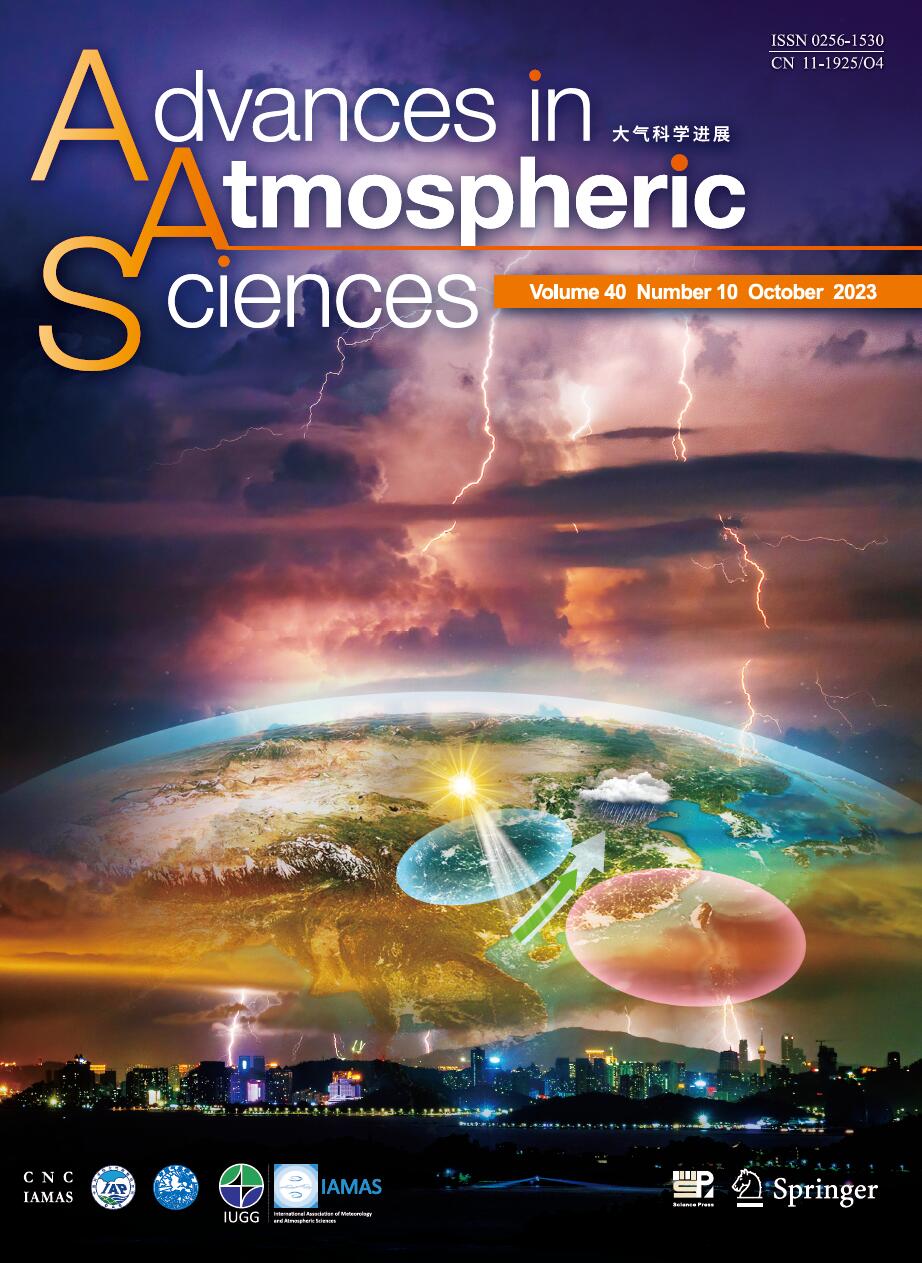| [1] |
Hyo-Eun JI, Soon-Hwan LEE, Hwa-Woon LEE,
2013: Characteristics of Sea Breeze Front Development with Various Synoptic Conditions and Its Impact on Lower Troposphere Ozone Formation, ADVANCES IN ATMOSPHERIC SCIENCES, 30, 1461-1478.
doi: 10.1007/s00376-013-2256-3
|
| [2] |
SUN Yang, WANG Yuesi, ZHANG Changchun,
2010: Vertical Observations and Analysis of PM2.5, O3, and NOx at Beijing and Tianjin from Towers during Summer and Autumn 2006, ADVANCES IN ATMOSPHERIC SCIENCES, 27, 123-136.
doi: 10.1007/s00376-009-8154-z
|
| [3] |
LI Mingwei, WANG Yuxuan*, and JU Weimin,
2014: Effects of a Remotely Sensed Land Cover Dataset with High Spatial Resolution on the Simulation of Secondary Air Pollutants over China Using the Nested-grid GEOS-Chem Chemical Transport Model, ADVANCES IN ATMOSPHERIC SCIENCES, 31, 179-187.
doi: 10.1007/s00376-013-2290-1
|
| [4] |
Hailiang ZHANG, Yongfu XU, Long JIA, Min XU,
2021: Smog Chamber Study on the Ozone Formation Potential of Acetaldehyde, ADVANCES IN ATMOSPHERIC SCIENCES, 38, 1238-1251.
doi: 10.1007/s00376-021-0407-5
|
| [5] |
LIU Yu, LI Weiliang, ZHOU Xiuji, I.S.A.ISAKSEN, J.K.SUNDET, HE Jinhai,
2003: The Possible Influences of the Increasing Anthropogenic Emissions in India on Tropospheric Ozone and OH, ADVANCES IN ATMOSPHERIC SCIENCES, 20, 968-977.
doi: 10.1007/BF02915520
|
| [6] |
Liang ZHANG, Bin ZHU, Jinhui GAO, Hanqing KANG,
2017: Impact of Taihu Lake on City Ozone in the Yangtze River Delta, ADVANCES IN ATMOSPHERIC SCIENCES, 34, 226-234.
doi: 10.1007/s00376-016-6099-6
|
| [7] |
A.M.Selvam, M.Radhamani,
1994: Signatures of a Universal Spectrum for Nonlinear Variability in Daily Columnar Total Ozone Content, ADVANCES IN ATMOSPHERIC SCIENCES, 11, 335-342.
doi: 10.1007/BF02658153
|
| [8] |
XU Jun, ZHANG Yuanhang, WANG Wei,
2006: Numerical Study on the Impacts of Heterogeneous Reactions on Ozone Formation in the Beijing Urban Area, ADVANCES IN ATMOSPHERIC SCIENCES, 23, 605-614.
doi: 10.1007/s00376-006-0605-1
|
| [9] |
Junlin AN, Huan LV, Min XUE, Zefeng ZHANG, Bo HU, Junxiu WANG, Bin ZHU,
2021: Analysis of the Effect of Optical Properties of Black Carbon on Ozone in an Urban Environment at the Yangtze River Delta, China, ADVANCES IN ATMOSPHERIC SCIENCES, 38, 1153-1164.
doi: 10.1007/s00376-021-0367-9
|
| [10] |
Lan GAO, Xu YUE, Xiaoyan MENG, Li DU, Yadong LEI, Chenguang TIAN, Liang QIU,
2020: Comparison of Ozone and PM2.5 Concentrations over Urban, Suburban, and Background Sites in China, ADVANCES IN ATMOSPHERIC SCIENCES, 37, 1297-1309.
doi: 10.1007/s00376-020-0054-2
|
| [11] |
Yawei QU, Tijian WANG, Yanfeng CAI, Shekou WANG, Pulong CHEN, Shu LI, Mengmeng LI, Cheng YUAN, Jing WANG, Shaocai XU,
2018: Influence of Atmospheric Particulate Matter on Ozone in Nanjing, China: Observational Study and Mechanistic Analysis, ADVANCES IN ATMOSPHERIC SCIENCES, 35, 1381-1395.
doi: 10.1007/s00376-018-8027-4
|
| [12] |
Junhua YANG, Shichang KANG, Yuling HU, Xintong CHEN, Mukesh RAI,
2022: Influence of South Asian Biomass Burning on Ozone and Aerosol Concentrations Over the Tibetan Plateau, ADVANCES IN ATMOSPHERIC SCIENCES, 39, 1184-1197.
doi: 10.1007/s00376-022-1197-0
|
| [13] |
Xuan MA, Lei WANG,
2023: The Role of Ozone Depletion in the Lack of Cooling in the Antarctic Upper Stratosphere during Austral Winter, ADVANCES IN ATMOSPHERIC SCIENCES, 40, 619-633.
doi: 10.1007/s00376-022-2047-9
|
| [14] |
H. Kurtulus OZCAN, Erdem BILGILI, Ulku SAHIN, O. Nuri UCAN, Cuma BAYAT,
2007: Modeling of Trophospheric Ozone Concentrations Using Genetically Trained Multi-Level Cellular Neural Networks, ADVANCES IN ATMOSPHERIC SCIENCES, 24, 907-914.
doi: 10.1007/s00376-007-0907-y
|
| [15] |
WANG Feng, AN Junling, LI Ying, TANG Yujia, LIN Jian, QU Yu, CHEN Yong, ZHANG Bing, ZHAI Jing,
2014: Impacts of Uncertainty in AVOC Emissions on the Summer ROx Budget and Ozone Production Rate in the Three Most Rapidly-Developing Economic Growth Regions of China, ADVANCES IN ATMOSPHERIC SCIENCES, 31, 1331-1342.
doi: 10.1007/s00376-014-3251-z
|
| [16] |
Zou Han, Ji Chongping, Zhou Libo, Wang Wei, Jian Yongxiao,
2001: ENSO Signal in Total Ozone over Tibet, ADVANCES IN ATMOSPHERIC SCIENCES, 18, 231-238.
doi: 10.1007/s00376-001-0016-2
|
| [17] |
Zou Han, Ji Chongping, Zhou Libo,
2000: QBO Signal in Total Ozone over Tibet, ADVANCES IN ATMOSPHERIC SCIENCES, 17, 562-568.
doi: 10.1007/s00376-000-0019-4
|
| [18] |
Jingmei Yang, Jinhuan Qiu,
2009: An Empirical Model for Estimating Stratospheric Ozone Vertical Distributions over China, ADVANCES IN ATMOSPHERIC SCIENCES, 26, 352-358.
doi: 10.1007/s00376-009-0352-1
|
| [19] |
Zou Han, Zhou Libo, Jian Yongxiao, Liu Yu,
2002: An Observational Study on the Vertical Distribution and Synoptic Variation of Ozone in the Arctic, ADVANCES IN ATMOSPHERIC SCIENCES, 19, 855-862.
doi: 10.1007/s00376-002-0050-8
|
| [20] |
Yuhan LIU, Hongli WANG, Shengao JING, Ming ZHOU, Shenrong LOU, Kun QU, Wanyi QIU, Qian WANG, Shule LI, Yaqin GAO, Yusi LIU, Xiaobing LI, Zhong-Ren PENG, Junhui CHEN, Keding LU,
2021: Vertical Profiles of Volatile Organic Compounds in Suburban Shanghai, ADVANCES IN ATMOSPHERIC SCIENCES, 38, 1177-1187.
doi: 10.1007/s00376-021-0126-y
|















 AAS Website
AAS Website 
 AAS WeChat
AAS WeChat 
 DownLoad:
DownLoad: